Blog

Freddie Mac Dividend Will Fully Reimburse Taxpayers; Fannie is Close
Freddie Mac and Fannie Mae eachrnreported strong third quarter financial results today. For Freddie it was the eighth consecutivernprofitable quarter and for Fannie Mae the seventh. With the dividend payments to Treasury, Fannie will have returned more than 97% of taxpayer, and Freddie will eclipse their draw amount by a fraction of a percent.</p
Freddie Mac’s pretax income,rnthe second largest in the company’s history, was $6.5 billion and its netrnincome was $30.5 billion compared to pretax income of $4.9 billion in thernsecond quarter and net income of $5.0 billion. rnThe increase in net income was almost totally due to the $23.9 billionrnimpact of released valuation allowance on deferred tax assets. Comprehensive income was $30.4 billionrncompared to 4.4 billion the previous quarter. </p
Under the revised SeniorrnPreferred Stock Agreement the company has a dividend obligation to the U.S.rnTreasury of $30.4 billion. The agreementrnrequires both Freddie Mac and Fannie Mae to pass through all of their netrnincome less a retained buffer which will diminish over time. This quarter’s dividend will bring thernaggregate paid to Treasury since Freddie Mac was put into conservatorship torn$71.345 billion. The company receivedrndraws of $71.336 billion, and Treasury’s holdings of senior preferred stockrnremain at that level. </p
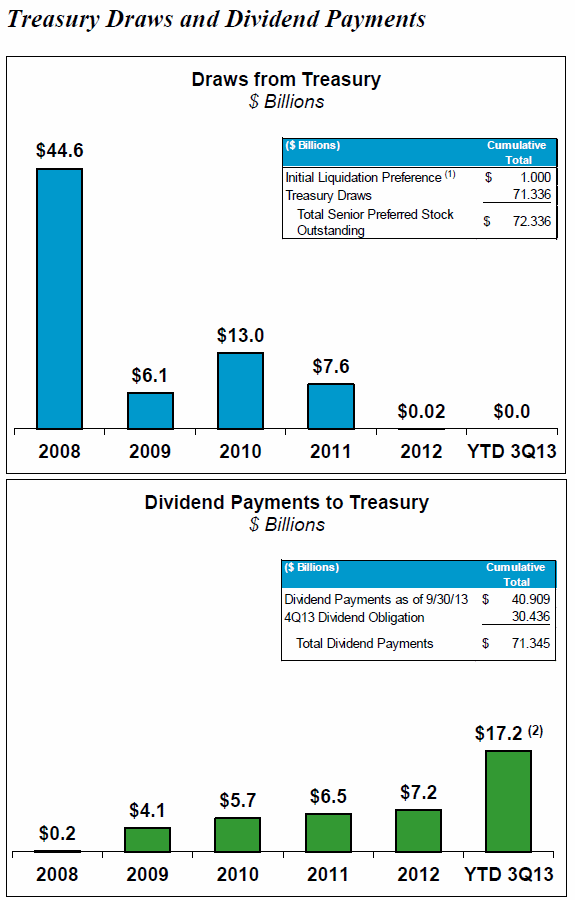 </p
</p
Thern$1.6 billion increase in pre-tax income primarily reflects higher otherrnnon-interest income driven by gains on securities and on multifamily mortgagernloans as well as settlement proceeds from private label securitiesrnlitigation. These numbers were partiallyrnoffset by third quarter derivative losses of $0.1 billion compared to $1.4rnbillion in gains in Q2. </p
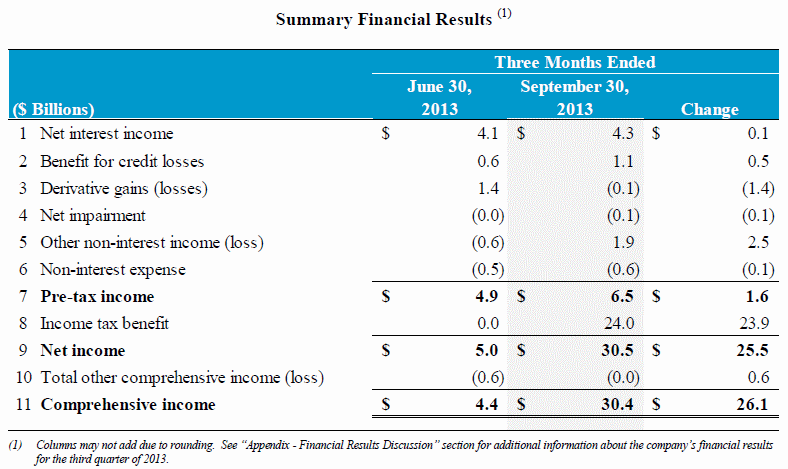 </p
</p
Inrnaddition to the tax benefits from the release of therndeferred tax asset valuation allowance, the increase in comprehensive income came from higher netrnquarter income from improved fair values on the company’s agency and non-agencyrnavailable-for-sale (AFS) securities.</p
Despite its recent string of positive results therncompany cautions the level of these earnings in recent periods is not sustainablernover the long term. Its financials havernbenefited from strong home-price appreciation which is expected to moderate,rnand have also included benefits from settlements of litigation with privaternlabel securities and repurchase claims. rnAlso the mandated shrinkage of its mortgage related investment portfoliornwill reduce earnings over time.</p
Freddie Mac reported that the credit quality of itsrnportfolio continued to grow as the share of that portfolio consisting of legacyrnloans decreased. The post-2008 book ofrnbusiness grew to 52 percent of the single-family credit guarantee portfoliornduring the third quarter excluding relief refinances which increased to 21rnpercent. Loansrnoriginated in 2005 through 2008 account for the majorityrnof the $73 billion inrnprovision for credit losses the company has recorded sincernthe beginning of 2008 and these continue to represent arndeclining portion of therncompany’s single-family credit guaranteernportfolio. </p
The company completed approximately 128,000 workoutsrnduring the first nine months of 2013 including over 60,000 loanrnmodifications. It has also continued tornpromote neighborhood stability by promoting sales of owned real estate (REO) tornnon-investors. Approximately 2/3 of REOrnsales since 2009 have been to owner occupants.</p
The serious delinquency rate among single family loansrnwas 2.58 percent at the end of September compared to 2.79 percent at the end ofrnJune. While still abnormally high, the company says it compares favorably withrnthe national rate of 5.88 percent reported by the Mortgage Bankers Associationrnat the end of June. The multifamilyrndelinquency rate (loans 60 days or more past due or in foreclosure) was 0.05rnpercent at the end of the third quarter compared to 0.09 percent at the end ofrnthe second.</p
Fannie Mae reported a quarterlyrnprofit in the third quarter of 2013 of $8.7 billion compared to $10.08 billionrnin the second quarter and $1.8 billion in the third quarter of 2013. Comprehensive income was $8.6 billion. Comprehensive income in the prior quarterrnwas $10.25 billion and was $2.56 billion in the Q3 2012.</p
The company will pay $8.6rnbillion in dividends to the U.S. Treasury bringing its total payments duringrnconservatorship to $114 billion. Seniorrnpreferred stock held by Treasury remained at $117.1 billion. </p
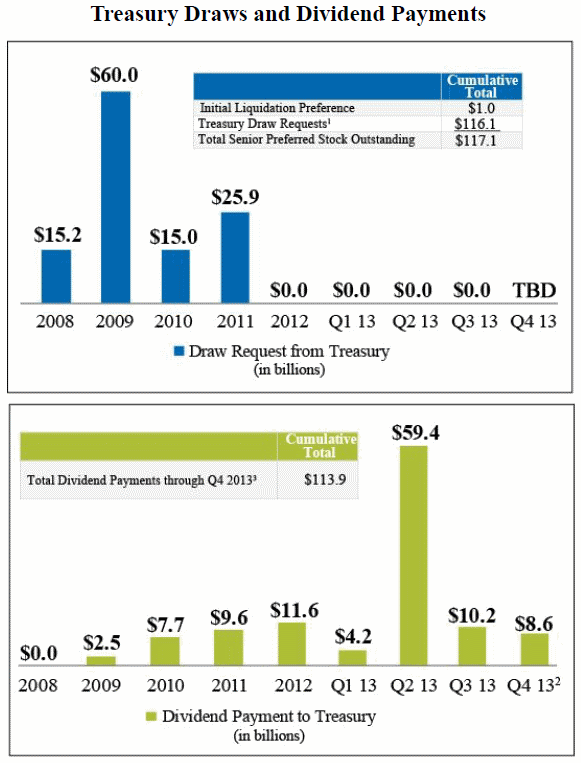 </p
</p
Fannie Mae saidrnits strong quarterly results come primarily from continued stable revenues andrncredit-related income. Home prices increased during the quarter which resultedrnin a reduction of loss reserves recognition of fees received from Bank ofrnAmerica from a compensatory fee agreement also contributed to credit relatedrnincome. </p
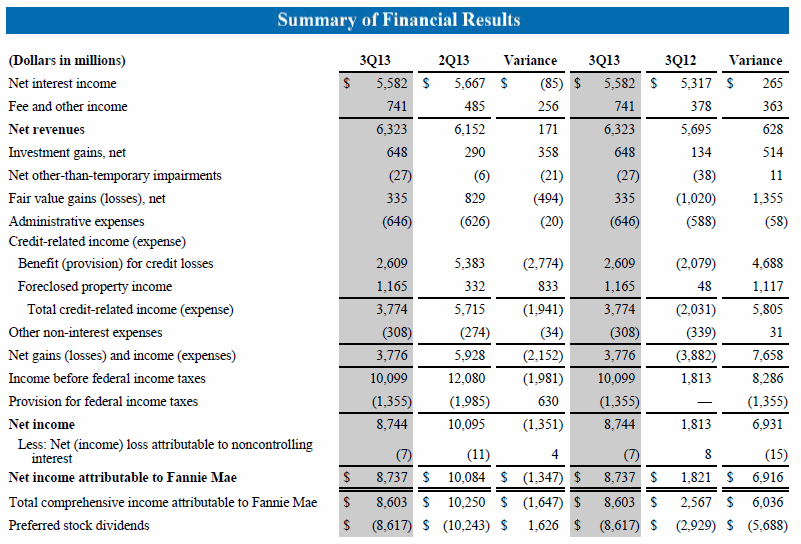 </p
</p
Fannie Mae continued to providernliquidity and stability in the mortgage markets. It remained the largest single issuer ofrnsingle family mortgage-related securities in the third quarter with an estimatedrn48 percent share in the third quarter. rnDuring the second quarter, the last period for which information is available,rnit owned or guaranteed approximately 21 percent of the outstanding debt on multifamilyrnproperties. </p
The company saysrnthe quality loans acquired since 2009 continue to be strong. In the first nine months of 2013 singlernfamily conventional loans acquired by the company had a weighted averagernborrower FICO score of 754 and a weighted average loan to value ratio of 75rnpercent. Loans originated since 2009 now comprise 75rnpercent of Fannie Mae’s single-family conventional guaranty book ofrnbusiness. </p
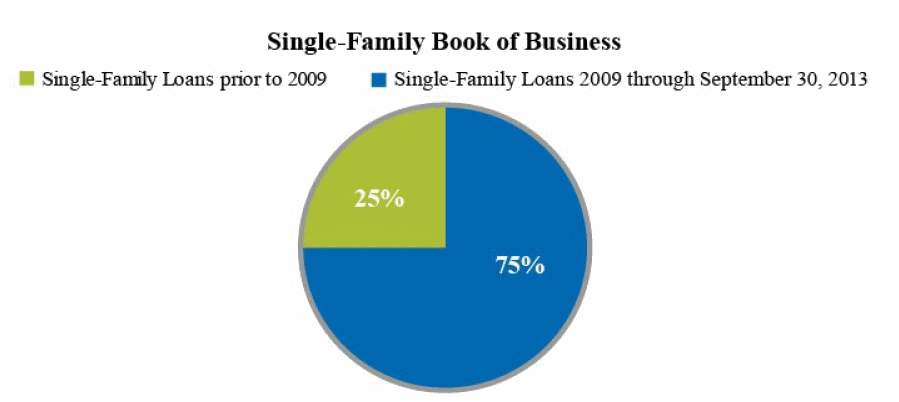 </p
</p
Fannie Mae’srninventory of single-family foreclosed properties (REO) increased in the thirdrnquarter to 100,941 units compared to 96,920 units at the end of June. The company said that it both acquired morernsingle family properties, 37,353 compared with 36,106 in the second quarter butrnsaw dispositions of REO slow. Therncarrying value of the REO portfolio was $10.0 billion at the end of thernquarter. The company’s single familyrnforeclosure rate, that is the annualized total number of properties acquired throughrnforeclosure or deeds-in-lieu as a percentage of loans in its guaranty book ofrnbusiness, was 0.85 percent for the first nine months of 2013.</p
All Content Copyright © 2003 – 2009 Brown House Media, Inc. All Rights Reserved.nReproduction in any form without permission of MortgageNewsDaily.com is prohibited.
Latest Articles
By John Gittelsohn August 24, 2020, 4:00 AM PDT Some of the largest real estate investors are walking away from Read More...
Late-Stage Delinquencies are SurgingAug 21 2020, 11:59AM Like the report from Black Knight earlier today, the second quarter National Delinquency Survey from the Read More...
Published by the Federal Reserve Bank of San FranciscoIt was recently published by the Federal Reserve Bank of San Francisco, which is about as official as you can Read More...

Comments
Leave a Comment